As Trump Eyes P3 Infrastructure Approach, Report Stresses Pivotal Role of Technical Advisors

Shutterstock

Connecting state and local government leaders
The Fitch credit rating agency’s guidelines could prove useful if there’s an uptick in public-private partnership activity once the next president takes office.
President-elect Donald J. Trump has outlined plans for substantial new spending on U.S. infrastructure that would rely heavily on private sector investment.
Should there be an upswing in the number of public-private partnerships, also called P3s, in the coming years, Fitch Ratings on Friday issued a report that some state and local governments may find useful. It highlights the importance of technical advisor firms in P3 projects.
“Technical advisor firms provide a pivotal link for investors to better understand various aspects of the project . . . and keep the investment community informed of progress toward completion and any unforeseen issues that arise,” Fitch senior director Scott Zuchorski said in a statement.
In releasing the report, the credit rating agency pointed to recent difficulties with several P3s, including the Interstate 69 Section 5 project in Indiana.
That project involves converting about 21 miles of Indiana’s State Road 37 into an interstate highway, with four overpassess and four interchanges. It has seen delays and disputes involving the private developer leading the project, contractors, and the Indiana Finance Authority.
For those with a stake in a P3, technical advisor firms would ideally identify these sorts of risks as early as possible in the course of the project.
Analysis from the firms is a factor in credit ratings, which influence borrowing expenses and in turn overall project costs.
The Fitch report goes into great detail. But here are a few highlights when it comes to what the rating agency looks for with technical advisors and the information they provide:
- The credentials of the firm and whether they have experience with similar projects, carried out under the same conditions and in the same jurisdictions.
- Credible and comprehensive written reports, in which the advisors make clear the sources and limitations of the information provided.
- Reports that cover areas such as: design, construction and completion risks; operation and maintenance and life cycle risks; and contractual requirements.
- A risk matrix that shows how risks are distributed between different parties.
- Monitoring, with the technical advisor providing regular updates about the project’s schedule and its budget—monitoring might continue into the project’s operation stage.
Trump’s Infrastructure Plan
Details about Trump’s infrastructure plans were outlined in a policy paper his campaign issued on Oct. 27. The paper was authored by Wilbur Ross, who is a private equity investor, and Peter Navarro, a business professor at the University of California, Irvine.
A central component of the proposal is nearly $137 billion worth of federal tax credits for companies that would build, manage or operate infrastructure—like roads, airports and water systems. The paper suggests the credits could attract $167 billion in private investment.
Ross and Navarro estimate the tax credit program would lead to private entities borrowing enough additional money to help finance up to $1 trillion of projects over a decade.
They also make the case that gains in tax revenues from the projects—specifically taxes on wage income and contractor profits—will offset the cost of the tax credits. In other words, they expect that in the end the plan wouldn’t cost the federal government any money.
Trump’s proposal has already encountered criticism. Route Fifty’s Atlantic Media sibling publication, CityLab, took a look at some of its implications earlier this week.
It’s important to note that private companies only have an incentive to pump money into infrastructure projects if there’s a promise of a return on their investment, which might come from tolls, user fees or some other source of revenue.
As Ross and Navarro note in their paper: “For infrastructure construction to be financeable privately, it needs a revenue stream from which to pay operating costs, the interest and principal on the debt, and the dividends on the equity.”
A full copy of the Fitch report can be found here.
Bill Lucia is a Reporter for Government Executive’s Route Fifty and is based in Washington, D.C.

NEXT STORY: Databases in the cloud: dark cloud or silver lining?





